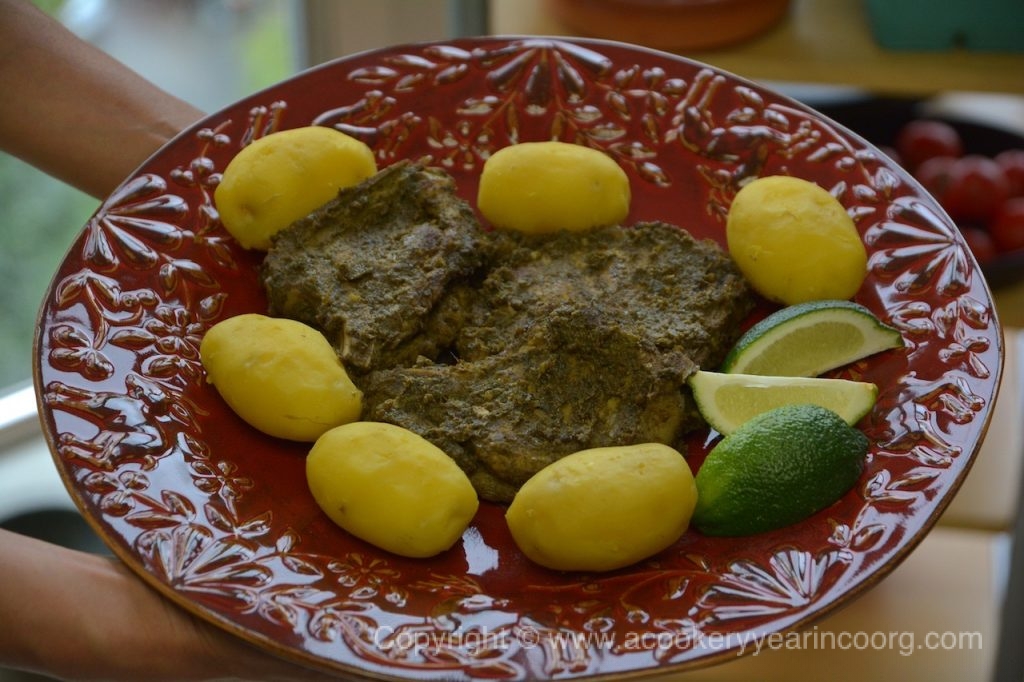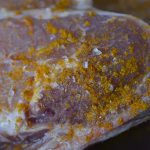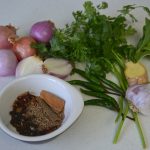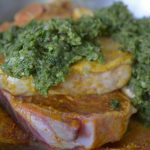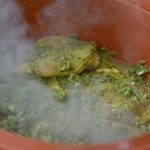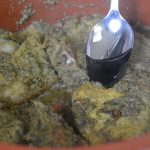A year has flown by, and Kail Podh is here again.
What’s on the menu in my home? Well, the classic duo of pandi curry and kadambuttu has made way for something just a little lighter this time.
This delicious recipe for pork chops was shared by a friend. It doesn’t use the more traditional dark roasted spices used in pandi curry. It relies, instead, on the freshness of herbs along with just enough heat and spice to make it a year-round favourite.
Serve up with rice, kadambuttu or bread. This time I’ve chosen some lovely locally grown potatoes to accompany the chops.
Pandi chops barthad
Braised pork chops
- 1 kg pork chops, with skin and fat*
- 1 cup of shallots or sambar onions
- 2 pods of garlic
- 3″ piece of ginger
- 10-12 green chillis
- 1/2 cup packed each of fresh coriander and mint
- 1 tbsp cumin
- 1/2 – 1 tbsp black peppercorns
- 2″ stick of cassia
- 5-6 cloves
- Salt to taste
- 1 tbsp malt vinegar
- 1 tsp turmeric
- 1/2 tsp kachampuli to finish
Rub the turmeric, vinegar and some salt into the chops and set aside.
Grind the remaining ingredients (except salt and kachampuli) to a coarse paste. You may need to grind the dry spices separately first.
Marinate the chops in the ground spices for about an hour.
Heat a wide, heavy bottomed pan, then pour in a little water (about 3-4 tbsp) and swirl it around to moisten the base. This helps prevent the fat from browning instead of melting.
Place the chops in the pan and cook on high heat for a few minutes, until the ground masala paste loses most of its moisture. Flip the chops over to ensure even cooking. Turn the heat down, cover, and continue to cook on a low heat. Sprinkle on a little water if it looks like it may be drying** out. When the meat is tender, check for salt and add a little more if needed.
Add the kachampuli, mix thoroughly, and cook on low heat for a few minutes.
Uncover, turn up the heat again and dry out the sauce until the chops are gently frying in the fat that has rendered out. When finished, the chops should be coated with a thick, fragrant sauce.
Dish them up with a flourish.
Happy Kail Podh!
* If this cut is not available, or you prefer to use a leaner, trimmed cut, add a few slices of thick pork belly to the recipe. This recipe does not work well without a reasonable amount of fat! Render some of the fat from the belly pieces in the first stage of the recipe before adding the chops, and proceed as above.
**Pork chops available here in Vancouver tend to cook much faster than what I use in India, and also have a higher moisture content. They typically do not require the addition of extra water.

